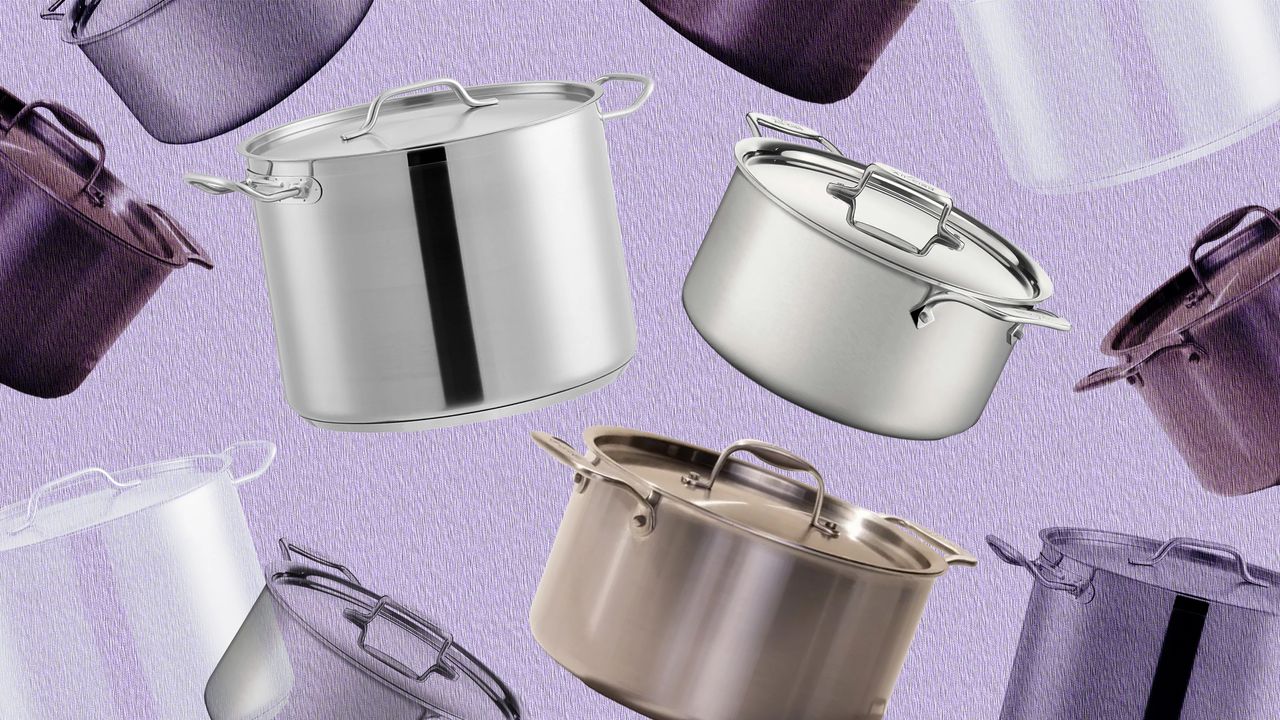The All-Clad D3 strikes a good balance between sturdiness and maneuverability. It has riveted handles, a seamless base, and comes with a stainless steel lid (All-Clad also sells glass lids separately if you prefer those).
What we’d leave: Compared to the Made In stockpot, this one is slightly heavier and the handles are a bit smaller, but we’re really splitting hairs here. The biggest gripe here is the price. $350 is quite a hefty price to pay for a single piece of cookware. While it is the best stockpot, we think it’s definitely worth considering how often you’ll use it. Then again, you will never have to buy another stockpot in your life, so it is certainly worth it in the long run.
Dimensions: 14.3 x 11.4 x 6.8″
Material: 3-ply Stainless steel
Size: 8 qt.
Weight: 5 lb.
How we tested and picked the best stockpots
We compared the performance of seven different stockpots first by cooking a batch of chicken stock to see how the pots handled their most essential task. We needed pots large enough to accommodate four pounds of chicken wings, two onions, two carrots, and four celery stalks.
We timed how long it took to boil the same volume of water in each pot, and then cooked pasta to see how easy it was to handle, maneuver, and drain the pot into the sink.
We cooked 1 pound of beans in each pot, to get a sense of what it was like to cook smaller amounts of food and how easy it was to reach inside when cooking.
Bon Appétit’s deputy food editor, Hana Asbrink, who made or had made for her enough miyeokguk, Korean seaweed soup to eat it every day for over a year after giving birth to her daughter, contributed her thoughts. We also spoke with Renee Erickson, a James Beard Award–Winning chef, restaurateur, and cookbook author; Tyler Malek, pastry chef and cofounder of Salt & Straw; and Angelo Sosa, chef at Kembara and Tía Carmen in Phoenix.
What makes a good stockpot?
In terms of material, chefs I talked to recommended stainless-steel stockpots over the cheaper aluminum models ubiquitous in restaurant supply shops. “The absolute worst is when the pot starts to warp on the bottom; a trait that almost anyone who has worked in a commercial kitchen has seen” Tyler Malek says. Malek has dealt with the warping issue a lot in his capacity as the pastry chef and cofounder of ice cream maker Salt & Straw. “The only way to avoid this is to buy thick bottomed, stainless-steel pots. Stainless steel also tends to heat more evenly and consistently, which is especially helpful when trying to get finicky recipes like caramel sauce to come out perfect every time.”
Aluminum stockpots can also leave a bad taste in your mouth—literally. “Oftentimes, when you cook with acidity in an aluminum pot, the metal taste transfers and the pans tarnish quickly,” says Angelo Sosa, chef at Kembara and Tía Carmen.
One final problem with aluminum stockpots: They don’t work on induction cooktops. Aluminum isn’t compatible with the technology. If you want more on the pots and pans that will work with induction you can check out this guide.
We also don’t recommend nonstick stockpots because you shouldn’t use high heat on nonstick coatings (Teflon or ceramic); high heat can cause them to break down. Nonstick cookware can also scratch easily, which is not good news in a pot that you need to deglaze and scrape.
You’re looking for the same things in a stockpot that you’d look for in saucepans or frying pans: responsiveness to changes in heat and even heat distribution. However, since stockpots tend to be used for much longer sessions than many other pieces of cookware, their ability to withstand hours of heat on the stovetop—and effectively distribute that heat to all parts of the pot—is even more important. A quality stockpot should also be oven-safe so it can stand in for jobs that call for a Dutch oven in a pinch (another reason you don’t want a nonstick stockpot).
There are a few other details that the experts look for as well. Are the base of the pot or the handles welded on? “It’s really important to get handles that are riveted rather than spot-welded. They will hold up longer and are way less likely to fall off the pot,” says Renee Erickson, chef and owner of Sea Creatures restaurant group in Seattle.
Another hallmark of a cheap stockpot is a seam between the sides and the base of the pot. After repeated use, that warping mentioned by Malek can cause the seams to actually begin to leak, and no one wants a pot that functions like a colander.
As a result, the pots we recommend are the most expensive of the lot we’ve tested, but that’s because they are the ones built to last the hours and hours on a hot stove we expect a stockpot to handle.
What can you cook in a stockpot?
Stock. Obviously. You want something big to handle a whole turkey carcass for leftover Thanksgiving stock, or the myriad of aromatics, chiles, and chicken parts that amp up this sinus-clearing spicy chicken stock.
But a stock pot isn’t just for soup lovers. You can use a stockpot in almost any recipe that calls for a large, heavy-bottomed pot or Dutch oven (except for maybe this bread recipe). Try a comforting navy bean and escarole stew, these rich and jammy red wine–braised short ribs, and this no-sweat chicken adobo. Use it for cooking long pasta like fettuccine or bucatini. Finally, if you’re into giving homemade edible gifts and want to whip up large batches of caramel, almond brittle, or jam to give to friends, follow Malek’s lead. The Salt & Straw cofounder says he relies almost exclusively on stockpots when he’s making toppings and mix-ins on a large scale for his ice creams.
Other pots we tested
Cuisinart Chef’s Classic Stainless-Steel Stock Pot
This is an excellent budget choice for a stockpot. It has cool grip handles and a superb tight-fitting lid that minimized drips and spills when we removed the lid to check on food. This pot is taller and narrower than our winners though, which we weren’t as crazy about. This is a disk bottom pot, so the bottom is clad with an aluminum core, while the sides are just stainless steel. There are a few reasons disk bottom pots and pans aren’t as good as fully clad pans: They are more prone to scorching and less responsive to changes in temperature. This isn’t really an issue when a pot is filled with water, as heat cycles through the pot with the movement of the water. But if you need to brown anything in the pot you might run into issues. If you’re primarily interested in making stock in your stockpot, and aren’t worried about anything getting scorched, a disk bottom pan like this is fine.
Cooks Standard 8-Quart Stainless Steel Stock Pot
This pot is similar to the Cuisinart, but is just a bit taller and narrower (if we didn’t like the shape of the Cuisinart as much as our top picks, we like this one even less). It’s a disk bottom pan, which is part of the reason it’s so affordable. Testers weren’t as crazy about the handle shape on this pot, preferring the flat style of the Cuisinart and All-Clad for transporting and holding.
Le Creuset Enamel-on-Steel 8-Quart Stock Pot with Lid
As charming and attractive as Le Creuset cookware is, we don’t think that enamel coating here is really the way to go, when bare stainless steel is just as fine, especially when you consider the customer reports that the enamel on their steel products seems to be easier to chip.
RSVP International Endurance 8-Quart Stock Pot
The pot was the tallest and narrowest of the pots we tested, and felt a bit on the flimsier side. It performed alright in the tests, but we had questions regarding its potential longevity.
Cook N Home Stainless-Steel 8-Quart Stock Pot
This is the Amazon favorite pan for it’s affordability, but the side walls felt a bit thin despite weighing the same as the All-Clad.
Source link









